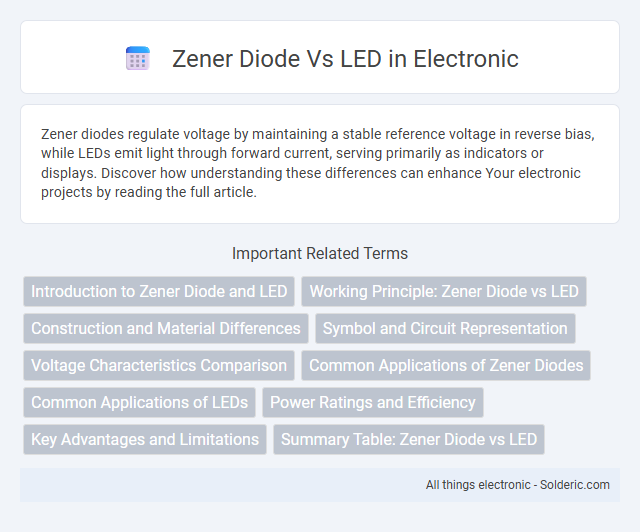Zener diodes regulate voltage by maintaining a stable reference voltage in reverse bias, while LEDs emit light through forward current, serving primarily as indicators or displays. Discover how understanding these differences can enhance Your electronic projects by reading the full article.
Comparison Table
| Feature | Zener Diode | LED (Light Emitting Diode) |
|---|---|---|
| Primary Function | Voltage regulation and reference | Light emission |
| Operating Principle | Breakdown voltage in reverse bias | Forward bias electron-hole recombination |
| Typical Voltage Range | Voltage varies (typically 2.4V to 200V) | Forward voltage 1.8V to 3.3V |
| Current Flow | Reverse biased current at breakdown voltage | Forward current only |
| Application | Voltage regulation, voltage clamping, surge protection | Indicators, displays, lighting |
| Light Emission | No | Yes |
| Polarity | Cathode marked, operates in reverse bias | Anode and cathode marked, operates in forward bias |
| Symbol | Zener diode symbol | LED symbol |
Introduction to Zener Diode and LED
Zener diodes are semiconductor devices designed to allow current to flow in the reverse direction when a specific breakdown voltage is reached, commonly used for voltage regulation and protection in electronic circuits. LEDs (Light Emitting Diodes) are semiconductor diodes that emit light when forward biased, widely utilized for indication and illumination purposes. Both Zener diodes and LEDs are integral components in modern electronics, each serving distinct functions based on their electrical characteristics and applications.
Working Principle: Zener Diode vs LED
A Zener diode operates by allowing current to flow in the reverse direction when the voltage exceeds a specific breakdown value, maintaining a stable voltage across its terminals. An LED (Light Emitting Diode) works by emitting light when forward-biased, as electrons recombine with holes within the semiconductor material. Understanding these distinct working principles helps you select the right diode for voltage regulation or illumination applications.
Construction and Material Differences
Zener diodes are constructed with heavily doped p-n junctions made primarily from silicon, designed to operate in reverse breakdown mode, while LEDs use a lightly doped p-n junction made from compound semiconductor materials like gallium arsenide or gallium phosphide to emit light. The silicon-based Zener diode focuses on voltage regulation and protection, whereas the LED's construction emphasizes photon emission through recombination of electrons and holes. Your choice between these devices depends on whether you need voltage stabilization or light emission functionality.
Symbol and Circuit Representation
The Zener diode symbol features a standard diode shape with bent edges on the bar, indicating its voltage regulation function, while the LED symbol includes arrows pointing away, representing emitted light. In circuit diagrams, the Zener diode is typically placed in reverse bias to regulate voltage at a specific breakdown level, whereas the LED operates forward biased to emit light when current passes through. The Zener diode is commonly used in voltage regulation circuits, and the LED is primarily used as an indicator or illumination source.
Voltage Characteristics Comparison
Zener diodes exhibit a well-defined reverse breakdown voltage, typically ranging from 2.4V to several hundred volts, where they maintain a stable voltage across terminals for voltage regulation purposes. LEDs have a forward voltage drop usually between 1.8V and 3.3V, depending on the material and color, and do not operate in reverse bias without damage. The Zener diode's voltage characteristic curve is sharply defined around the reverse breakdown point, while the LED's forward voltage increases gradually with current, highlighting their distinct operational behaviors in circuits.
Common Applications of Zener Diodes
Zener diodes are widely used in voltage regulation circuits to maintain a stable output voltage despite variations in input voltage or load conditions. They serve as voltage references in precision measurement instruments and provide protection by clamping voltage spikes in power supplies and signal lines. Common applications include surge suppressors, voltage regulators, and waveform clippers in electronic circuits.
Common Applications of LEDs
LEDs are widely used in display screens, indicator lights, and general lighting owing to their high efficiency and long lifespan. They serve critical roles in automotive lighting, traffic signals, and electronic devices for clear visual communication and energy savings. Unlike Zener diodes, which primarily function as voltage regulators or surge protectors, LEDs focus on emitting light when an electrical current passes through them.
Power Ratings and Efficiency
Zener diodes typically have higher power ratings than LEDs, making them suitable for voltage regulation in high-power applications. LEDs convert electrical energy into light with efficiencies ranging from 20% to 40%, whereas Zener diodes dissipate excess voltage as heat, resulting in lower energy efficiency. Your choice depends on whether you need efficient light emission or robust voltage stabilization under varying power conditions.
Key Advantages and Limitations
Zener diodes offer precise voltage regulation and reliable voltage reference capabilities, making them ideal for protecting circuits from overvoltage conditions; however, they have limited current handling capacity and are not designed for illumination. LEDs provide efficient light emission with low power consumption and long operational life, but they lack voltage regulation properties and are sensitive to reverse voltage. Both components serve distinct purposes in electronic design, with Zener diodes excelling in voltage stabilization and LEDs in visual signaling.
Summary Table: Zener Diode vs LED
Zener diodes regulate voltage by allowing current to flow in reverse when a specific breakdown voltage is reached, making them essential for voltage stabilization. LEDs (Light Emitting Diodes) emit light when forward biased, used primarily for indication and illumination purposes. Key differences include operating voltage, application in circuits, and function--with Zener diodes focusing on voltage regulation and LEDs on light emission.
Zener diode vs LED Infographic

 solderic.com
solderic.com